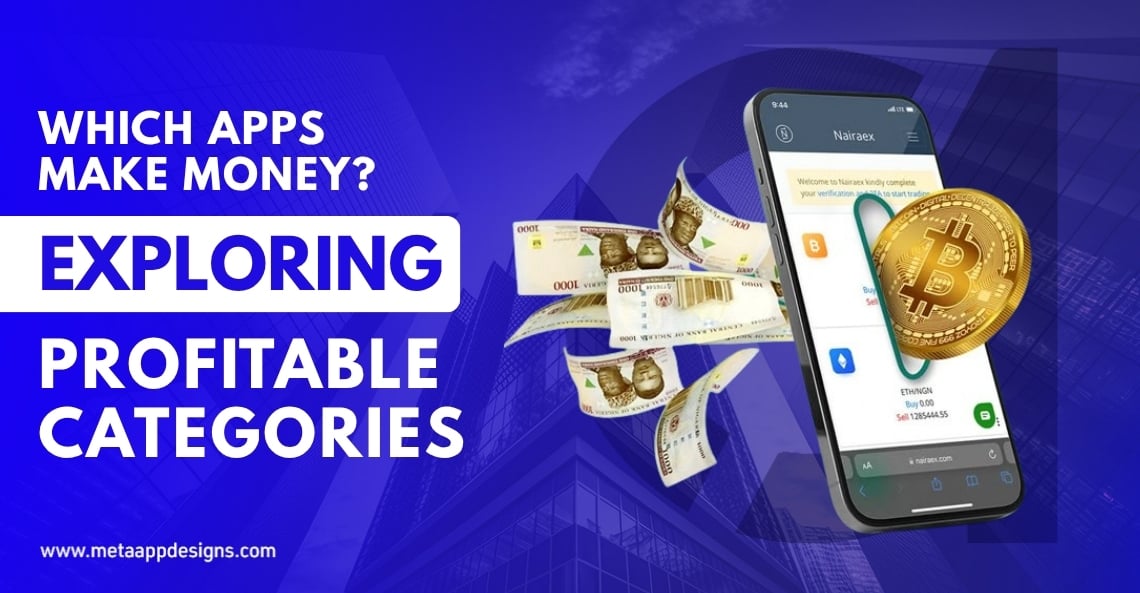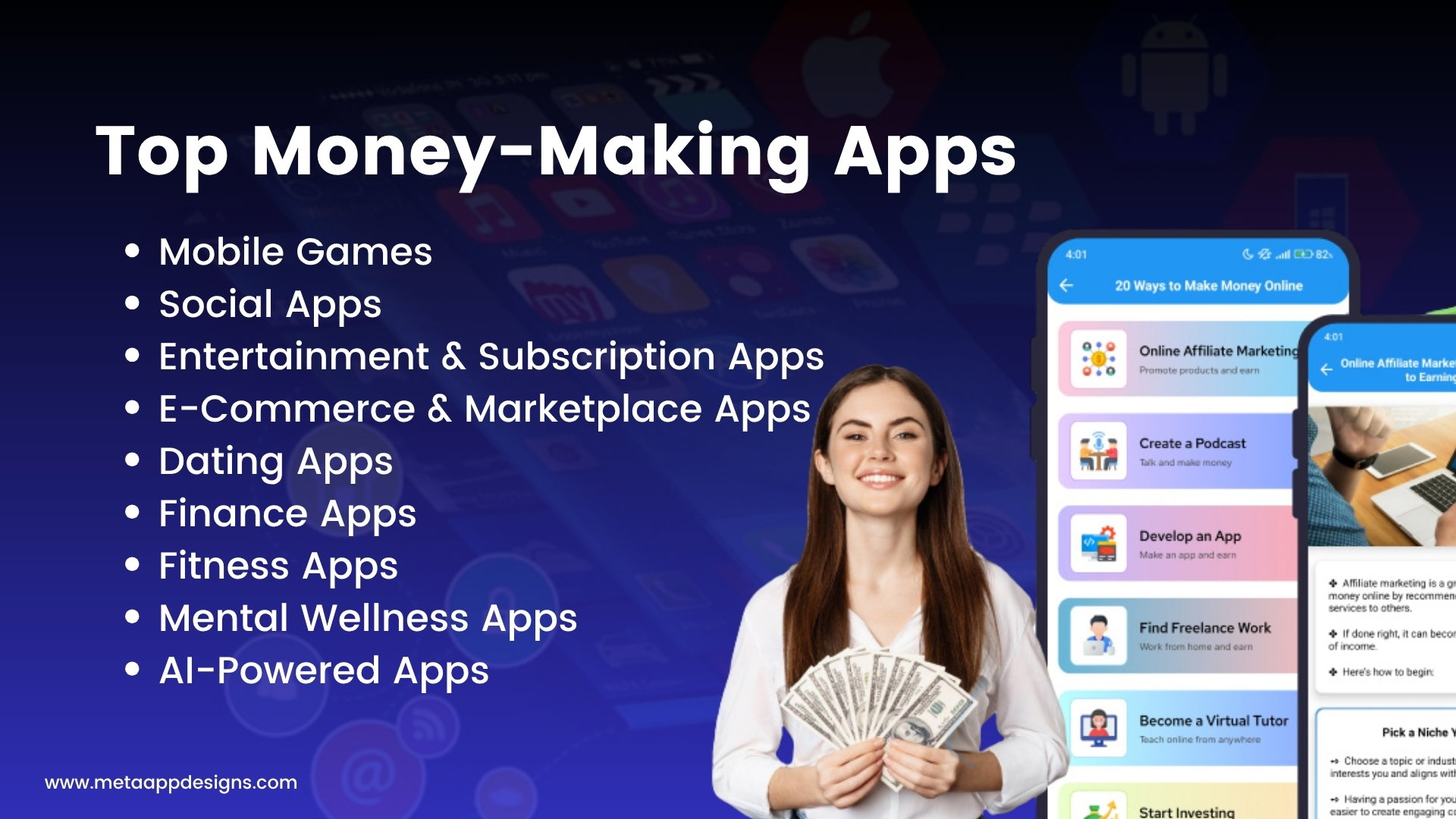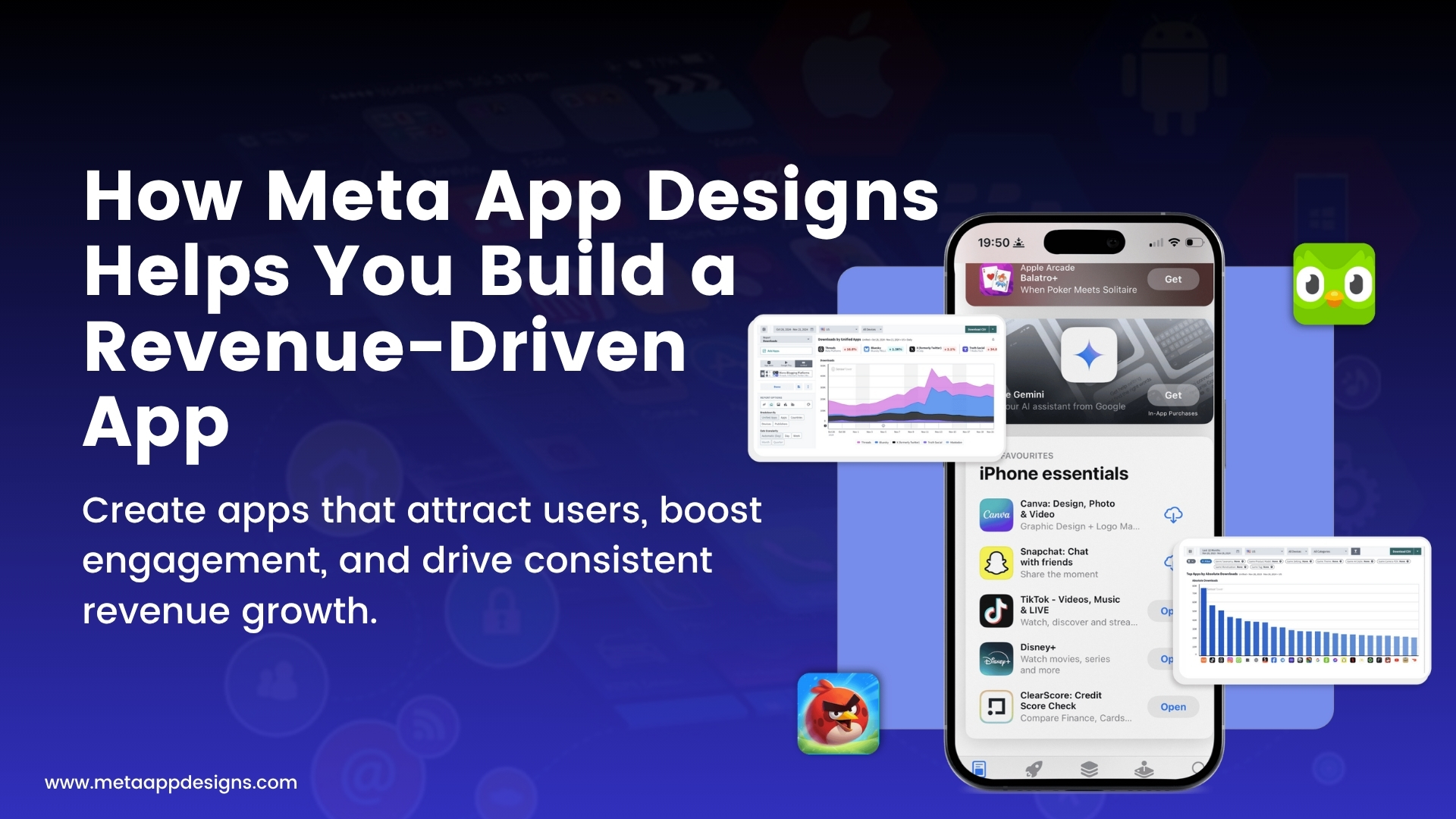
Which Apps Make Money? Exploring Profitable Categories
Some apps print money. Others… they just sit in your phone like a gym membership you swore you’d use. In today’s digital world, mobile apps are more than tools; they are full-blown business engines. With global mobile app revenue expected to cross $613 billion by 2025 (Statista), it’s clear the right idea plus smart execution can pay off. From mobile game app development to ecommerce app development and even taxi booking app development, the opportunities are huge. When you mix strong strategy, user-focused design, and smart monetization, you don’t just launch an app, you build a money-making system. And yes, it can scale beautifully.
Thank you for reading this post, don't forget to subscribe!Why Certain Apps Make More Money
Not all apps are built equal. Some become daily habits, while others fade faster than a New Year workout plan. So, why do certain apps turn into revenue machines?
First, they target industries where people already spend heavily. Think finance, e-commerce app development, healthcare app development, and mobile game app development. When users are willing to pay for value, the path to profit becomes easier.
Next, high-earning apps understand user behavior.
- They study how people interact
- what keeps them engaged
- and what motivates them to return
This is why features like push notifications, reward systems, and social engagement work so well. Users stay longer. And longer usage means more earning potential.
Another key factor? It’s hybrid monetization. The most successful apps don’t rely on a single revenue source. Instead, they blend ads, in-app purchases, premium subscriptions, or even transaction fees.
Apps don’t just earn when you download. But they earn when you stick around.
Finally, successful apps are built with long-term vision. When paired with expert mobile app development services? These elements turn ideas into scalable, profitable digital products.
Top Money-Making App Categories

1. Mobile Games
Mobile games are basically the rockstars of the app world. People play everywhere, from lunch breaks to late-night “one more level” moments. And clearly, the obsession pays off. Global revenue is on track to cross $138 billion by 2025, which honestly makes sense when you see how sticky these games are.
Most are free to download, which feels harmless… until you buy coins, skins, passes, and little digital swords. In-app purchases, rewarded ads, and season passes power the big wins here.
The lesson? Games don’t just entertain. They master retention.
If your app keeps users returning, it has the same money-making potential whether it’s mobile game app development, food delivery app development, or even grocery app development.
2. Social Apps
Social platforms print money by keeping people connected. Ads, digital gifts, subscription badges, creator features, all of it creates a flowing economy. Every click, like, and share builds value.
But the trend now? Niche social communities.
Fitness squads. Travel buddies. Book clubs. Faith circles. People love belonging, not just scrolling.
So if you’re building a social app, design features that spark real interaction. Smooth chat, reactions, group spaces, easy sharing, when people talk, your app thrives.
Social success = engagement first, monetization second.
3. Entertainment & Subscription Apps
Streaming apps are the VIPs of subscription models. Movies, shows, podcasts, live sports, users pay because convenience beats flipping channels. And yes, content licensing and competition can be intense, but the demand isn’t slowing down.
Winning here comes down to consistency. Deliver content people love. Recommend smartly. Keep everything simple and smooth.
With a solid library and a smart retention strategy, entertainment apps keep revenue steady and predictable, something every founder dreams of.
4. E-Commerce & Marketplace Apps
Shopping apps turned our phones into malls. From everyday essentials to luxury resell platforms, users love browsing, comparing, and buying in minutes. And with mobile commerce heading toward $4.5 trillion+ by 2027, this space is only getting bigger.
These apps earn through product sales, commissions, promoted listings, and sometimes even subscriptions.
But here’s the catch: competition is brutal.
Fast checkouts, secure payments, clean UI, smooth filter, all of it matters.
Great ecommerce app development helps brands scale, but differentiation keeps them alive. In a crowded market, a unique beats “just another store.”
5. Dating Apps
Dating apps turned “meeting someone” into a swipe ritual. Boosts, subscriptions, premium filters, even digital currency users pay for better chances at connection.
And with the new generation entering the dating scene in full force, spending patterns are shifting toward micro-purchases and emotional UX. People want authenticity, comfort, and the feeling that the app “gets them.”
Winning here means experimenting with features and pricing. Love is emotional… and so is monetization in this space.
6. Finance Apps
Finance apps put banking, budgeting, investing, and trading right in your hand. And people take them seriously. In fact, 40%+ of users say they’re willing to pay for good financial tools.
Monetization flows through subscriptions, premium upgrades, ads, and sometimes ethical data insights. But the real key? Trust and simplicity.
Clean design. Secure authentication. Strong encryption. Helpful guidance without confusing terms.
If users trust you with their money, they’ll stay, and they’ll pay for peace of mind.
7. Fitness Apps
Fitness apps sell results and motivation. From workouts and training programs to live classes and nutrition plans, users are happy to pay for routines that help them stay on track. With the market expected to hit $10 billion by 2028, this field isn’t slowing down.
Most combine subscriptions, coaching upgrades, and sometimes in-app product sales. But the heroes here are personalization and habit-building.
When people feel progress, they keep going and keep subscribing.
8. Mental Wellness Apps
Mental wellness is no longer a side topic. But it’s a priority. Apps offering meditation, journaling, sleep support, and therapy-style tools are growing fast. Especially more as the industry is heading toward $14.7 billion by 2030.
These apps often use subscriptions and premium content, and many now include AI-guided emotional support. But trust matters most here. Users need privacy, warmth, and a safe space.
If your UX feels calming and ethical, retention soars, because mental health is personal, not transactional.
9. AI-Powered Apps
AI apps are everywhere now, productivity tools, education apps, creative platforms, even dating and wellness. They win because they learn from user behavior and keep getting smarter.
Subscription plans, pay-per-use, and premium AI features make monetization flexible. But what truly drives growth is personalization.
When a tool feels like it “knows” the user, leaving becomes hard.
For brands, this is where innovation shines. With the right custom app development strategy, AI becomes not just a feature, but a value engine.
Key Monetization Strategies To Learn From
Table Of Content

Mobile apps don’t make money by accident. They follow proven models, tested by the biggest platforms in the world. And honestly, the smartest apps mix a few together instead of relying on just one stream. Here are the core strategies worth understanding if you want your app to grow and actually earn.
1. Freemium Systems
Users can access the basics for free, then pay for premium features. It lowers the barrier to entry and builds trust first. Think: try before you commit.
2. Subscriptions
These are either monthly or yearly plans that unlock full access. It’s predictable, steady revenue. PLus, it’s great for apps that deliver ongoing value like fitness, finance, or education platforms.
3. Advertisements
Free apps often rely on targeted ads. When done right, ads are subtle and don’t interrupt the user experience. Balance is everything here.
4. In-App Purchases
Digital goods, upgrades, coins, extra features users spend when they see value. Works especially well in gaming and lifestyle apps.
5. Paywalls & Pricing Tests
Some features stay locked unless you pay. And yes, successful apps keep testing prices, bundles, and timing to see what users respond to.
6. Hybrid Models
Most top-earning apps mix subscriptions, in-app purchases, and ads for layered revenue.
What It Really Takes To Build a Profitable App
Building a profitable app isn’t magic. It’s strategy, patience, and understanding what users actually need, not just what looks cool on a pitch deck. First, you need clear value. Apps win when they solve one real problem really well. Whether it’s educational app development, healthcare app development, or even food delivery app development, clarity beats complexity every time.
Next, study user behavior. What do people search for? When do they open your app? What makes them stay? Data isn’t just numbers, it helps you build features people will genuinely use and enjoy.
Then comes smart execution. Good design, smooth performance, and reliable functionality are non-negotiable. So, work with a team that understands all that from day one.
However, the journey doesn’t stop at launch.
- Keep testing features
- Keep fixing the pricing
- and take care of the user flows
Remember, markets evolve, and your app should too.
And finally, even the best product needs visibility. That means marketing, PR, and retention strategies that create long-term connection. When you combine clear value, ongoing improvement, and strong brand presence? Your app doesn’t just launch. But it grows, earns, and stays relevant.
How Meta App Designs Helps You Build a Revenue-Driven App

When it comes to building a profitable mobile app, Meta App Designs goes beyond just writing code, we help you build a business. First, we offer custom mobile app development solutions tailored to your idea, target audience, and growth goals. No cookie-cutter templates here, just smart, purpose-built products.
Next, we build with scalable architecture and performance in mind. So as your user base grows, your app runs smoothly without lag, crashes, or chaos. Because let’s be honest, users won’t stick around for an app that moves slower than airport Wi-Fi.
Plus, we take a user-centric design approach. That means intuitive flows, clean UI, and smooth interactions, everything your users need to enjoy the experience and keep coming back.
However, development alone isn’t enough. That’s why we provide monetization consulting at every stage. From pricing to revenue models, we help you choose strategies that drive real profit, not just downloads.
And finally, our startup-friendly development approach keeps budgets, timelines, and flexibility in check. We scale with you, step by step, so your app grows from idea to industry player, confidently and sustainably.
The Future Belongs To Apps That Think Big
At the end of the day, building a profitable mobile app isn’t about chasing trends. Nor is it about copying what’s already out there. Instead, it’s about clarity, strategy, and consistent innovation.
Because users don’t just want an app. But they want an experience, a routine, a tool that makes life easier or more enjoyable.
And yes, the market is competitive. But that’s not a threat, it’s a sign of opportunity. New ideas win every single day. So, if you combine solid planning, smart development, and thoughtful monetization, success becomes a real, achievable outcome, not just a dream pinned to a pitch deck.
However, you don’t need to figure it out alone. With the right tech partner guiding your app build, shaping your user experience, and supporting your monetization strategy, you move faster, smarter, and stronger.
Frequently Asked Questions
Gaming apps lead globally, but fintech, ecommerce, and subscription-based lifestyle apps also earn big when they solve real user needs.
It varies. Some apps start earning within months, while others take a year or more. Strong marketing, user retention, and ongoing updates speed up the journey.
Both work well. Subscription apps create stable long-term revenue, while ad-based apps scale fast with high traffic. The best choice depends on your audience and value offer.
Templates are quick and low-cost, but custom app development gives you flexibility, scalability, and a unique edge, especially if you want long-term growth.
- Ecommerce App
- Educational App
- Food Delivery App
- Mobile Apps
- Mobile Game App
- Money Making App
Table Of Content







